
9. X-Pigeons |
||||
BA - Ash-red
In an ash-red phenotype the wing bars and checks appear to be brick-red color on a clear silver body, and the tail bar is not clearly visible. The otherwise bluish "ground" color is gray-like with reddish tones. When we look at an ash-red pigeon, we should notice neither wing bars nor the sub-terminal tail band are the same color as it is on a wild-type (blue/black) bird. The sub-terminal tail band in ash-red pigeons has been washed out to an ashy-gray color. In the blue and brown series birds have positive tail band where tail band is more pigmented than the rest of the tail. An ash red on the other hand, has a negative tail band where tail band is with less pigment than the rest of the tail. When ash-red is combined with spread the entire bird is gray or ash color with only very faint red showing. In ash-red birds the sub-terminal tail bands and the albescent strip are very difficult if not impossible to see clearly. Initially the term dominant red was used for the ash-red mutation but W. F. Hollander wisely chose the name ash-red, because of the characteristic washing out to ashy or ashen coloration associated with the gene. Ash-reds wash-out to gray (ash) towards the tail and ends of the flight feathers. This so-called “mark of the ash” is reliable identification clue of ash-red phenotype.
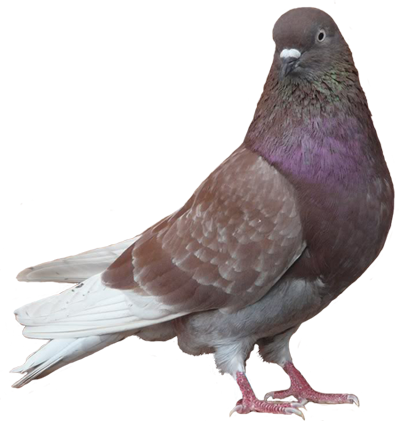 Breeding
data proves that ash-red is a sex-linked dominant mutation. Heterozygous
ash-red males carrying blue or brown will show black
or brown flecks in their phenotype especially in the tail and flights
even when they are very young. So, if you see such an ash-red pigeon
with dark flecks, more than likely it is a male. Males heterozygous
for ash-red and brown have brown flecks. Conventional pigeon genetics
from the Hollander era suggest that brown or black flecking in
ash-red can only happen to male ash-red birds that are split for
either blue or brown. However, it is quite common for hen ash-reds
to produce black flecks. Or flecks that are a mix of red and black
pigments. In fact, a hen ash-red that is able to produce brown
pigment is a very rare case, but such hen does exist. So, we have
two types of ash-red hens. Some of them are able to make black
pigment and a very tiny number are able to make brown pigment.
Breeding
data proves that ash-red is a sex-linked dominant mutation. Heterozygous
ash-red males carrying blue or brown will show black
or brown flecks in their phenotype especially in the tail and flights
even when they are very young. So, if you see such an ash-red pigeon
with dark flecks, more than likely it is a male. Males heterozygous
for ash-red and brown have brown flecks. Conventional pigeon genetics
from the Hollander era suggest that brown or black flecking in
ash-red can only happen to male ash-red birds that are split for
either blue or brown. However, it is quite common for hen ash-reds
to produce black flecks. Or flecks that are a mix of red and black
pigments. In fact, a hen ash-red that is able to produce brown
pigment is a very rare case, but such hen does exist. So, we have
two types of ash-red hens. Some of them are able to make black
pigment and a very tiny number are able to make brown pigment.
Now, you should be asking if ash-red and brown were alleles and because hens only have one functional sex-chromosome, how could they have two mutated genes (ash-red and brown) at the b-locus at the same time? This is one of the reasons many people questioned the possibility that ash-red and brown may not be alleles as Hollander once suggested.
The term ash-red is used for many variations of colors and patterns that are somewhat similar in appearance, but very different phenotypically. Patterns in ash-red involving distribution of pigment are the same as in blue-black. Although phenotype is called ash-red, keep in mind that the actual pigment is red. Ash-red bar sooty is often called mealy by racing fanciers. Ash-red bar is often called "silver" by roller breeders. Ash-red spread is called lavender or barless mealy (even though in reality the bird is not barless) by many breeders. T-pattern check ash-red with Lebanon bronze modifier is called “ribbon-tail”. A red bar pigeon with some white on its head is often called a silver (or mealy) pied by a racing homer breeder but the same colored bird would be known as a silver badge by a Birmingham Roller breeder.
Why do we have many phenotypical names to ash-red variants? It’s because, pigeon fanciers from different parts of the world, breeding different pigeon breeds described the color and pattern of the birds, and call the phenotype produced by more than one mutation a different name long before their genetics was studied.
The ash-red is produced by mixture of red that consist of a very low concentration of mainly black pigments. Same mixture exist in all bronze phenotypes where all known reds in pigeons also contain black pigments which includes ash red, recessive red, ember, kite, Modena bronze, Arch bronze, indigo, etc. and by definition we call them all bronzes. The black pigment that contributes to make the ash-red appearance has more or less red incorporated into the individual pigment granules. Thus, we see from almost white wing shield ash-reds to fairly bronzy ash-reds in variety of pigeon breeds. In most ash-red hens, the mixture of black and ash-red pigment seems a bit lower overall concentration than normal in a cock bird and generally bronzier than in a cock bird.
There is also recessive red, which should not be confused with the ash-red. Ash red is a dominant color and has its genetic symbol as BA and the recessive red is lower case e indicating the recessive gene. Unlike Ash red, the recessive red is recessive to wild-type. In addition, recessive reds are not sex-linked. It is impoartant to underatand that pigment found in both of these mutants are red.
Cole and Kelly were to first to report on ash-red in 1919. They called this type "dominant red" but pointed out that it is not a uniform red, having more or less "washed-out" areas, especially the tail. Cole and Kelly found the dominant red in several breeds and demonstrated it to be sex-linked dominant to wild type. With the ash-red mutation, the bird's pattern is still visible. We can look at an ash-red bird and see if it's a barless, bar or checker or spread. The dilluted version of the ash-red is called: Ash-yellow or cream shown on the second picture below. The following pictures domonstrate the different ash-red patterns. Click on each picture to enlarge it.
1- Ash-red bar Turkish
Tumbler cock.
2- Yellow Ash-red
(Cream-Bar) Turkish Tumbler.
3-
Spread Ash-red Birmingham Roller cock.
4- T-pattern check ash-red also known as ribbon tail. Notice that this bird is not spread)
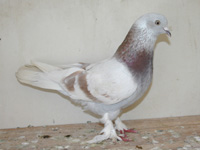 |
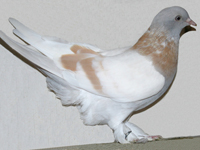 |
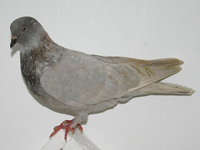 |
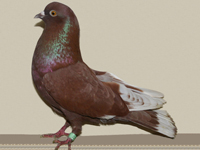 |
The following is the genetic explanation of the ash-red pigment and "possible" results when mated to other b locus pigments (blue/black and brown).
Homozygous ash-red cock (BA//BA) - Both alleles are ash-red, he has no choice but to donate one of the ash-red genes during mating. This also means that whichever hen (blue or brown) we mate this cock bird, all the offspring will be expressing ash-red in their phenotype. The male offspring will carry the other allele that they inherited from their mother, but will still be called an ash-red since ash-red is dominant to both blue and brown. All the female offspring from this cock bird will be ash-red.
Homozygous ash-red cock X ash-red
hen - All the cock birds will be homozygous
ash-red, all the hens will be ash-red.
Homozygous ash-red cock X blue
hen - All the cock birds will be heterozygous
ash-red carrying blue, all the hens will be ash-red.
Homozygous ash-red cock X brown
hen - All the cock birds will
be heterozygous ash-red carrying brown, all the hens will
be ash-red.
Heterozygous ash-red
cock (BA//+ or BA//b) -
This means he is carrying two different alleles at the b locus and
one of them is definitely ash-red, as it is expressed because of its
dominance. We don't know what the other pigment is but it has to be
either blue or brown. If you look closely at a heterozygous ash-red
cock there will be dark flecks in his feathers if he is carrying blue
or brown. The other allele this heretozygous ash-red cock is carrying
cannot be ash-red; otherwise he would be called homozygous ash-red.
During mating he can donate either the ash-red or the other (blue or
brown) allelic genes he is carrying. This means, he may not have ash-red
offspring if he donates the other alleles (blue or brown) he is carrying.
This may confuse a lot of people if they don't understand the genetics.
Heterozygous ash-red cock mated to ash-red hen may produce blue or
brown offspring (all the offspring will be hens if they are not ash-red).
How? Because he donated the other gene (blue or brown) he was carrying
on his other functional Z sex-chromosome and the ash-red hen donated
the non-functional (W) chromosome. 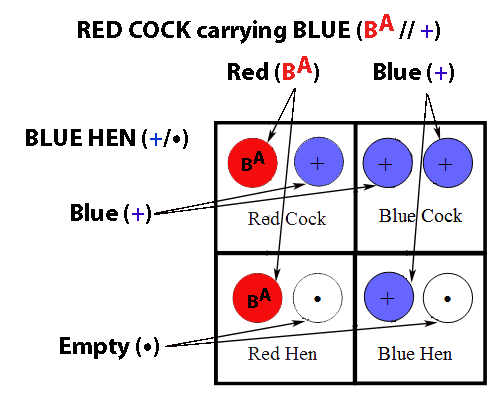
Heterozygous ash-red cock carrying blue X ash-red hen - 25% chance that cock birds will be homozygous ash-red, 25% chance that cock birds will be heterozygous ash-red carrying blue. 25% chance that hens will be ash-red and 25% chance that hens will be blue.
Heterozygous ash-red cock carrying blue X blue hen - The picture on the right is the Punnett square that shows the four different possibilities of this mating. 25% chance that cock birds will be homozygous blue if both parents donate blue (top right square in the picture). 25% chance that cock birds will be heterozygous ash-red carrying blue if the hen donates blue and the cock donates red (top left square in the picture). 25% chance that hens will be ash-red if the cock donates red and the hen donates empty--non functional sex chromosome (bottom left square in the picture). 25% chance that hens will be blue if the cock donates blue and the hen donates empty sex chromosome (bottom right square in the picture).
Heterozygous ash-red cock carrying blue X brown hen - 25% chance that cock birds will be heterozygous ash-red carrying brown, 25% chance that cock birds will be heterozygous blue carying brown. 25% chance that hens will be ash-red, 25% chance that hens will be blue. Notice that this mating can produce both blue and ash-red cock and hen offspring. None of the offspring will be brown pigmented in their phenotype, but all the cock offspring will carry brown in their genotype.
Heterozygous ash-red cock carrying brown X ash-red hen - 25% chance that cock birds will be homozygous ash-red, 25% chance that cock birds will be heterozygous ash-red carrying brown. 25% chance that hens will be ash-red, 25% chance that hens will be brown. All the brown offspring produced from this mating will be hens.
Heterozygous ash-red cock carrying brown X blue hen - 25% chance that cock birds will be heterozygous ash-red carrying blue, 25% chance that cock birds will be blue carrying brown. 25% chance that hens will be ash-red, 25% chance that hens will be brown. In other words, all the hens from this mating will either be ash-red or brown, but not blue. All the cocks from this mating will either be ash-red carrying blue, or blues carrying brown. Therefore, all the blue offspring from this mating will be cock birds carrying brown.
Heterozygous ash-red cock carrying brown X brown hen - 25% chance that cock birds will be homozygous brown. 25% chance that cock birds will be heterozygous ash-red carrying brown. 25% chance that hens will be ash-red, 25% chance that hens will be brown.
References:
1. Cryberg,
R. PhD. Private communication.
2. Hollander, W. F. (1983). Origins
And Excursions In Pigeon Genetics: A Compilation. Burrton, Kan.:
The Ink Spot.
3. Quinn,
Joe W. (1971). The Pigeon Breder’s Notebook. QB&Q Publishing.
Copyright July, 2011 by Arif Mümtaz